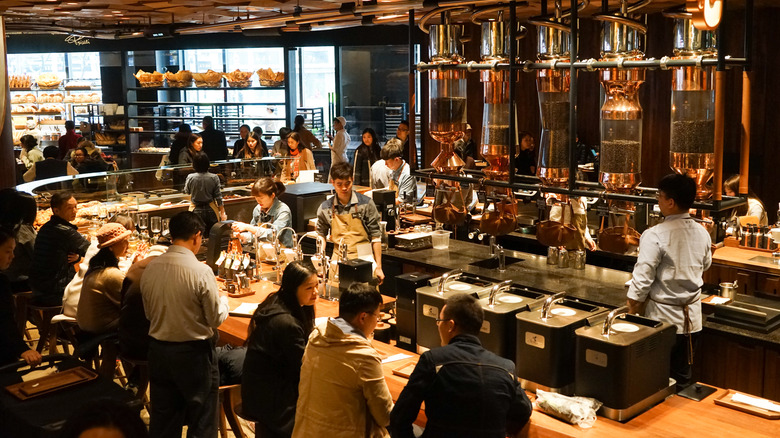Why Starbucks Didn't Focus On Coffee When It First Opened In China
When you think of Starbucks, the first thing you think of is probably coffee, which is good, since the multi-billion dollar company is primarily a coffee chain. Why then, when expanding their brand internationally, did a company whose name is practically synonymous with coffee shy away from its headlining product? The answer is a master class in market research.
Starbucks opened its first Chinese location in Beijing in 1999 and, as CNBC reports, the chain was successful "almost from day one," despite significant skepticism. Many western brands have failed to successfully transition into Asian markets, particularly in China, because of differing cultural attitudes and consumer habits. This is illustrated by Firmex, who documented how Home Depot and Mattel failed in their attempts to enter the Chinese market due to poor planning and insufficient market research. While making the jump is never a simple process for popular American chains, Starbucks faced another major hurdle: According to CNBC, China is the number one tea-consuming country in the world and had little market interest in coffee when the chain arrived in their country decades ago.
But rather than letting this uphill battle deter the coffee giant, Starbucks' corporate team decided to push ahead with plans to enter the world's largest consumer market, not by attempting to push its coffee line, but by focusing on its tea offerings.
Blending cultures
While Starbucks still offered some coffee items on its menu, CNBC notes that it tried to position itself in the Chinese teahouse market by creating new, tea-based beverages for its menu, incorporating local ingredients and traditions, and partnering with Chinese suppliers to appeal to consumers. Additionally, the stores were developed to be welcoming and encourage people to stay while leisurely enjoying drinks and socializing (per The PR Talk). Despite being designed to more seamlessly blend into Chinese cultural settings, Forbes notes that Chinese Starbucks locations still incorporate the modern, trendy designs and accommodations (like free wi-fi) that American consumers are used to, which makes them popular among the country's younger generations.
Currently, there are over 6,000 Starbucks locations in mainland China, with no plans to slow down expansion, making it the world's second largest market for the chain behind the U.S. (per CNBC). While the company's Chinese debut was largely focused on tea, and tea remains a big part of its Chinese menu, some things have changed: Younger consumers in China have begun to embrace coffee as well as tea, with the South China Morning Post noting that flavored, sweet coffee beverages like Frappuccinos have become increasingly popular. It goes to show that working to adapt to a local market can make all the difference for a brand going into new territory, and can even introduce new ideas to an established culture.

